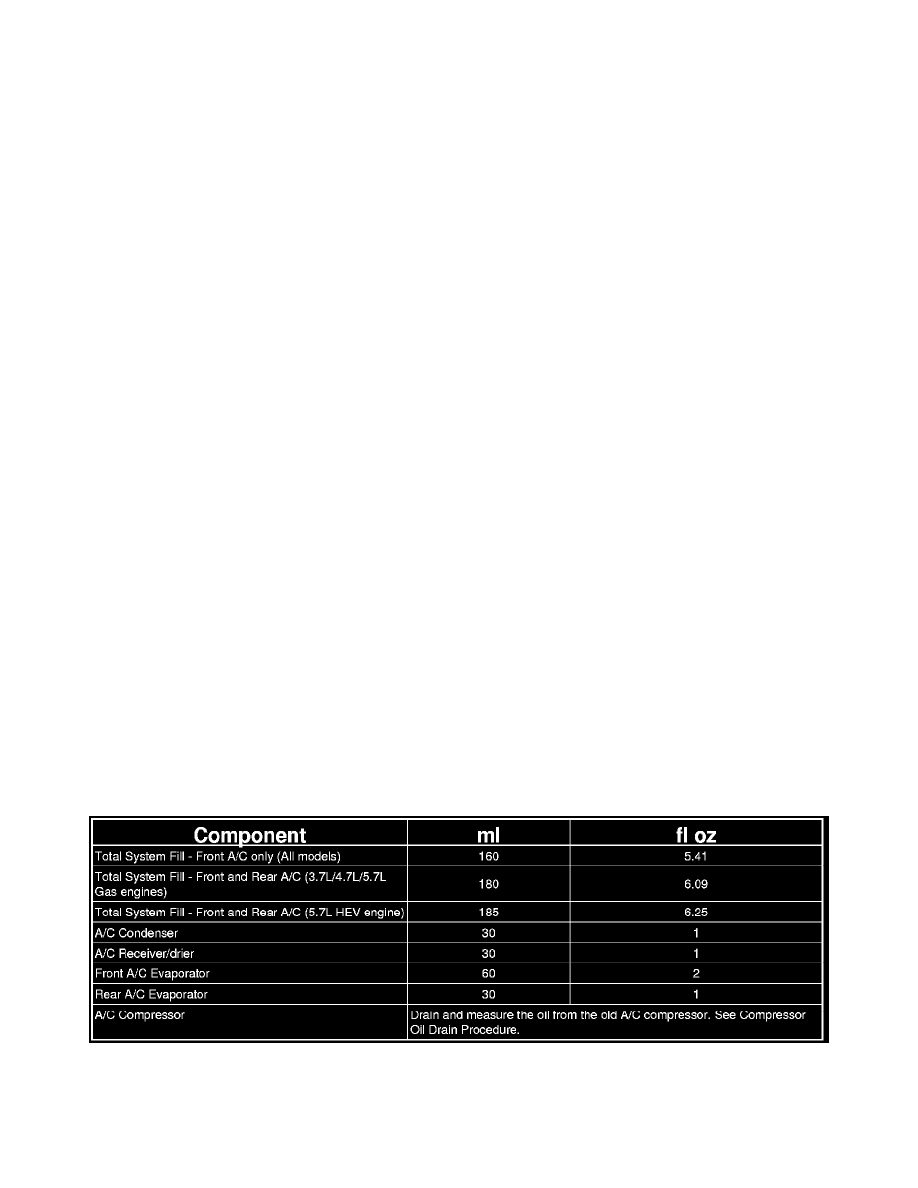Durango 2WD V8-4.7L Flex Fuel (2009)

Refrigerant Oil: Capacity Specifications
REFRIGERANT OIL CAPACITY
When an A/C system is assembled at the factory, all components except the A/C compressor are refrigerant oil free. After the refrigerant system has been
charged and operated, the refrigerant oil in the A/C compressor is dispersed throughout the refrigerant system. The A/C receiver/drier, A/C evaporator,
A/C condenser and the A/C compressor will each retain a significant amount of the needed refrigerant oil.
It is important to have the correct amount of refrigerant oil in the A/C system. This ensures proper lubrication of the A/C compressor. Too little oil will
result in damage to the A/C compressor, while too much oil will reduce the cooling capacity of the A/C system and consequently result in higher
discharge air temperatures.
CAUTION: Polyalkylene Glycol (PAG) oil can contaminate the refrigerant system of a Hybrid Electric Vehicle (HEV) and lead to A/C system
damage and failure. If the refrigerant recovery/recycling and charging equipment was last used on a non-HEV model, flush the
hoses of the equipment with a solvent approved by the equipment manufacturer before using the equipment on an HEV model, or
use refrigerant recovery/recycling and charging equipment designated only for HEV models by your service facility. See the
operating instructions supplied by the equipment manufacturer for proper use and care of the refrigerant recovery/recycling and
charging equipment.
CAUTION: ND-11 Polyester (POE) oil is used in the Denso ES34 A/C compressor found on HEV models. Never use PAG oil in an HEV model
or operate the A/C system with an incorrect amount of oil in the system. Failure to follow this caution may result in serious
damage to the HEV A/C system.
CAUTION: ND-8 PAG oil is used in the Denso 10SR17 and 10SRE20 A/C compressors found on gasoline engine models. Only refrigerant oil of
the same type should be used to service these A/C systems. Do not use any other refrigerant oil. Failure to follow this caution may
result in serious damage to the A/C system.
CAUTION: A/C refrigerant oil containers should be kept tightly capped until ready for use and then tightly capped after use to prevent
contamination from moisture and dirt. Refrigerant oil quickly absorbs moisture it comes in contact with, therefore, special effort
must be used to keep all A/C system components moisture-free. Moisture in refrigerant oil is very difficult to remove and will
cause a reliability problem with the A/C compressor.
NOTE: Most reclaim/recycling equipment will measure the lubricant being removed during recovery. This amount of lubricant should be
added back into the system. Refer to the reclaim/recycling equipment manufacturers instructions.
It will not be necessary to check the oil level in the A/C compressor or to add oil, unless there has been an oil loss. An oil loss may occur due to a rupture
or leak from a refrigerant line, a connector fitting, a component, or a component seal. If a leak occurs, add 30 milliliters (1 fluid ounce) of refrigerant oil
to the refrigerant system after the repair has been made. Refrigerant oil loss will be evident at the leak point by the presence of a wet, shiny surface
around the leak.
Refrigerant oil must be added when an A/C condenser, A/C receiver/drier or A/C evaporator is replaced (see Refrigerant Oil Capacities chart).
The refrigerant oil level in a new A/C compressor must first be adjusted prior to compressor installation (see Compressor Oil Drain Procedure).
REFRIGERANT OIL CAPACITIES
COMPRESSOR OIL DRAIN PROCEDURE
CAUTION: Be certain to adjust the refrigerant system oil level when replacing an A/C compressor. Failure to properly drain and measure the
refrigerant oil from the A/C compressor can prevent the A/C system from operating as designed and cause serious compressor
damage.
